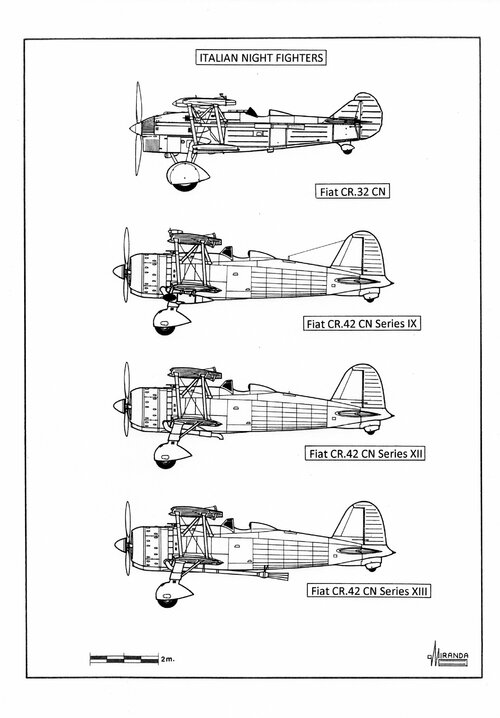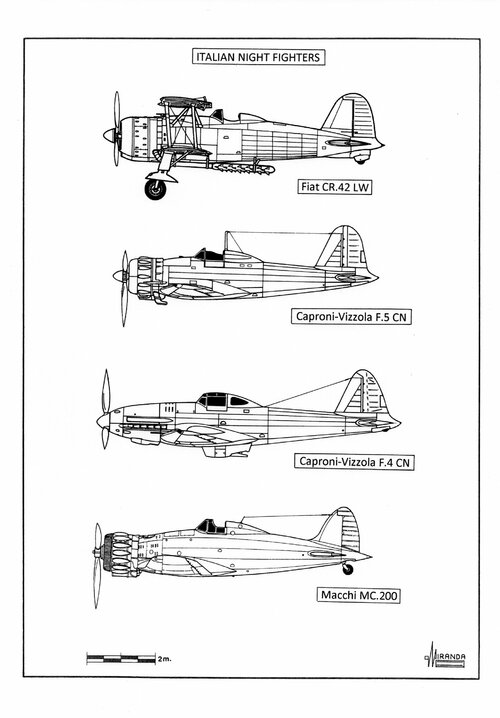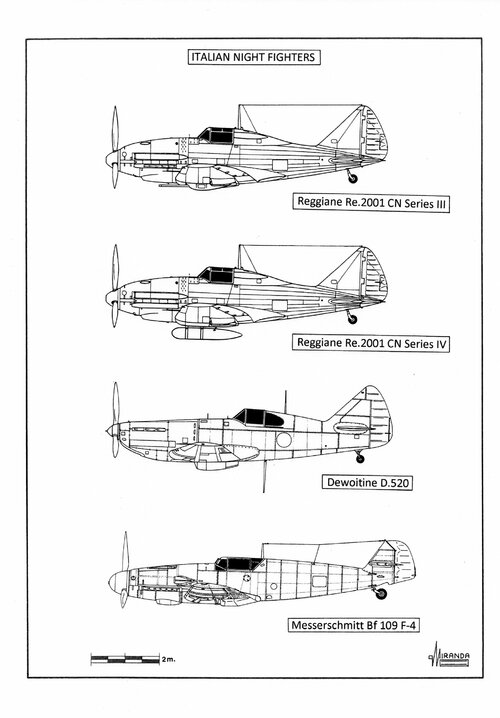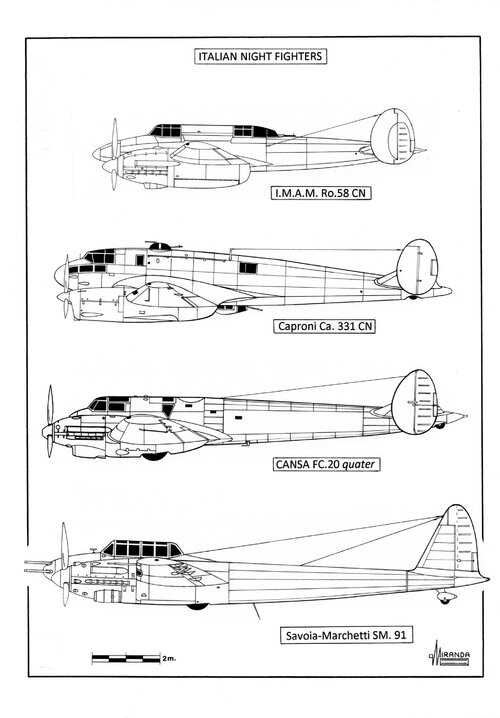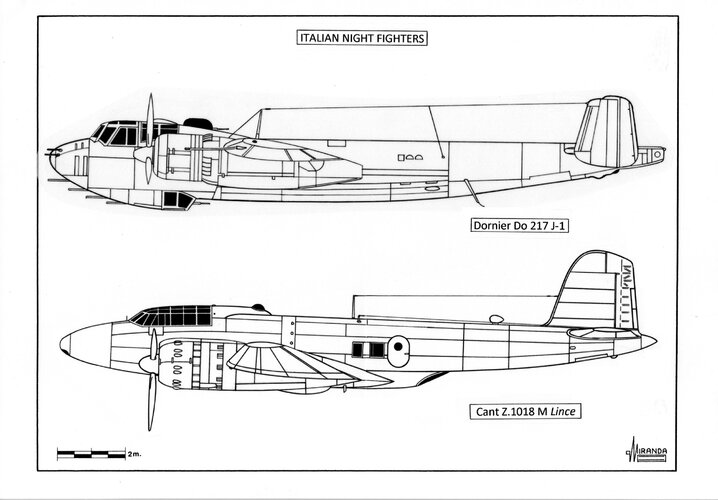Italian Night Fighters
When some Italian pilots tried to intercept the Republican Potez 542 night bombers during the Spanish Civil War they found that the Fiat CR.32 fighter was totally unsuitable for night operations. The exhaust blue flames of the A.30 engine caused the loss of night vision of the pilots during the take-off and taking 20 minutes to re-establish.
The Legion Condor suffered the same problem with their Arado Ar 68 E-1 night fighters and in 1938 they were modified by installing new exhaust flame dampers based on those of the Heinkel He 45C.
Between 1938 and 1939 night flying trials were conducted in the Centro Sperimentale di Guidonia with several Fiat CR.32 day fighters seized from the 71ª, 73ª and 85ª Squadriglie.
These airplanes were fitted with exhaust flame dampers of 14.4 feet length and flash-hidders. They were very effective but it was shown that they also considerably reduced the power of the engine and the speed of the plane.
The modified version was called Fiat CR.32 CN (Caccia Notturna) and was used between June and November 1940 by the 71ª Squadriglia, 7º Gruppo, based at Boccadifalco and by the 356ª Squadriglia, 21º Gruppo, based at Guidonia.
The night fighters were camouflaged with the C1A paint scheme: Giallo Mimetico 3 (Camo Yellow FS 33434) mottled with Verde Mimetico 3 (Camo Green FS 34102) and Marrone Mimetico 2 (Camo Brown FS 30076) upper surfaces and Grigio Azzurro Scuro 3 (Dark Blue Grey FS 36118) under surfaces, Bianco Neve 6 (Snow White FS 37875) ‘Fasci’ national markings.
The CN's top speed was only 211 mph (340 km/h) and was insufficient to intercept the RAF Whitley bombers (230 mph) who attacked Turin and Genoa during the night of 11/12 June, the French LeO 451 (308 mph) who attacked Palermo during the night of 23/24 June and the RAF Wellingtons (255 mph) who attacked Naples during the night of 30/31 October.
In theory, Italian night fighters could have intercepted the French Farman F.222.2 (199 mph) heavy bombers of the Escadrille Aéronavale 10E that attacked La Spezzia, Rossignano, Alghero and Livorno during the night of 14/15 June, but the speed difference was too small and the chase would have been too long for the Fiat’s short range.
In the late 1940s the CR.32 CN was replaced by the Fiat CR.42 day fighter.
Fiat CR.32 CN technical data
Wingspan: 31.2 ft. (9.5 m), length: 24.5 ft. (7.47 m), height: 8.6 ft. (2.63 m), wing area: 238 sq. ft. (22.1 sq. m.), max weight: 4,354 lb. (1,975 kg), max speed: 211 mph (340 km/h), service ceiling: 26,240 ft. (8,000 m), range: 485 miles (781 km), power plant: one Fiat A.30 RA, 12 cylinder, Vee, liquid cooled engine rated at 600 hp., armament: two nose mounted Breda SAFAT machine guns of 7.7-mm Mod. 1928 Av and 12.7-mm. Mod. 1935. One San Giorgio reflector gunsight.
Despite Giulio Douet's warnings about air power and the experience gained by the Aviazione Legionaria during the Spanish Civil War, Italy entered World War II with an inadequate air defense organization.
By May 1940 the Italian early warning system used sound locators aerophones, often operated by blind people, linked to several information-gathering centers, in turn connected to the Anti-Aircraft Territorial Defense Command (D.I.C.A.T.).
The raid alarm system comprised 150,000 civil observers of the National Union for Anti-Aircraft Protection (U.N.P.A.). Outside the cities, church bells often replaced the sirens and many alarms turned out to be false, because the air detection system was imprecise.
The Difesa Contraerea (Army Anti-Aircraft Artillery) used modern 90/53 heavy cannons, 37-mm Breda 37/54 light cannons and 20-mm Scotti heavy machine guns to cover sixty-six “First Degree” localities and antiquated 76/40 Mod.1916, 76/45 Mod.1911 cannons, with hand fire calculators, and French Saint Étienne Mod. 1907 machine guns to defend 265 “Second Degree” localities.
The Regia Aeronautica was responsible for fighter aircraft, the Army for the D.I.C.A.T. and the Regia Marina for the defense of their naval bases, using searchlights, balloon barrages and 90/53 heavy anti-aircraft cannons.
Many subsidiary industries related to aeronautical production were left unprotected.
During the first bombing raids carried out in June 1940 by the RAF, l'Armée de l'Air and the Marine Nationale the ineffectiveness of the Italian defensive system became evident, with overlapping and conflicting intentions, misunderstandings and delays.
The slow adaptation of Italian industry to the latest technology also resulted in delays in the production of more powerful aircraft engines, modern instrumentation, radio sets and high-octane fuel.
The Italian fighters of the time were underpowered, lacked of supercharged engines, radio and oxygen equipment and its small caliber weaponry was insufficient against the modern bombers.
The usual bombing height of the Bomber Command was 15,000-20,000 ft. and the service ceiling of the best Italian fighters dis not exceed 14,760-16,400 ft. (4,500-5,000 m).
The few CR.32 CN available lack a ground guidance system capable of directing them towards enemy bombers.
Only a few CR.42 day fighters attempted to intercept them during the nights with good visibility.
The night of 15/16 August 1940, one CR.42 from 365ª Squadriglia (operating without instrument panel lightning) rammed one Whitley Mk. V bomber form No. 101 Sqn. (LU) over Turin.
During the night of 15/16 December 1940 one CR.42 from 412ª Squadriglia downed a Vickers Wellesley light bomber from No. 223 Sqn (AO) over Asmara.
On 16/17 March 1941 one CR. 42 from 375ª Squadriglia downed a Wellington from No. 37 Sqn (FJ) over Tirana.
The night of 12/13 July 1941 one CR.42 of the 85ª Squadriglia downed a Wellington over Benghazi.
On 23/24 October 1942 one CR. 42 from 13º Gruppo CT downed one Halifax from No. 102 Sqn (DY) over Genoa.
Between December 1940 and July 1943 over 200 CR.42s were modified as CR.42 CN night fighters Series VII, IX, XII, XII and XV.
The Series IX version was equipped with night flying instruments, radio, artificial horizon, two underwings searchlights, flare launchers and one wind generator mounted over the top wing.
The Series XII version was equipped with “S” exhausts and the Series XIII with Guidonia-style long flame dampers with flash hidders.
The CR.42 CN type was used by the Squadriglie 73ª (Fuka-August 1942), 232ª (Venegono-June 1943), 233ª (Caselle-February 1943), 234ª (Venegono-September 1943), 235ª (Treviso-September 1943/Venegono-June 1943), 300ª (Gela-October 1941/Ciampino-June 1943), 303ª (Grottaglie-June 1943), 335ª (Treviso-September 1942), 356ª (Capodichino-December 1941), 375ª (Sarzana-June 1943), 377ª (Boccadifalco-July 1942) and by the 161º Gruppo Autonomo CT (Rhodes/Maritza-November 1941).
Despite all the difficulties the CN fighters managed to shoot down five Wellingtons, one Albacore, three Halifaxes and one Lancaster.
CR.42 CN paint schemes:
Until the summer of 1942 most aircraft retained the mottled standard day scheme C1A:
Giallo Mimetico 3 (Camo Yellow FS 33434) mottled with Verde Mimetico 3 (Camo Green FS 34102) and Marrone Mimetico 2 (Camo Brown FS 30076) upper surfaces and Grigio Mimetico (Camo Grey FS 36231) under surfaces, Bianco Neve 6 (Snow White FS 37875) ‘Fasci’ national markings with the White fuselage band painted in the lower half only.
Some aircraft from 300ª Squadriglia were camouflaged in mottled scheme C3A: Verde Mimetico 3 (Camo Green FS 34102) and Verde Mimetico 53192 upper surfaces and Grigio Mimetico (Camo Grey FS 36231) under surfaces, Grigio Azzurro Scuro (Dark Blue Grey FS 36118) top wing under surfaces transparent wing ‘Fasci’ in four positions, White fuselage band, Black codes and Red individual number.
In August 1942 all CN fighters were painted overall Grigio Azzurro Scuro 3.
In the airplanes of 233ª Squadriglia the wing identification markings were over sprayed with Grigio Azzurro Scuro.
In the 377ª Squadriglia only the Fasci of the upper wing were removed, the lower wing Fasci were of the low visibility type (White circle and fasces over Nero 12-Black), Red (Rosso 8) individual number over the fuselage band.
The planes of the 234th Squadriglia had the codes painted in Grigio Azzurro Chiaro (Light Blue Grey FS 36307).
In the 161º Gruppo Autonomo C.T. the individual number was repeated over the port top wing.
Fiat CR.42 CN technical data
Wingspan: 31.8 ft. (9.7 m), length: 27 ft. (8.26 m), height: 11.7 ft. (3.5 m), wing area: 248.8 sq. ft. (22.4 sq. m.), max weight: 5,066 lb. (2,295 kg), max speed: 267 mph (430 km/h), service ceiling: 26,240 ft. (8,000 m), range: 485 miles (781 km), power plant: one Fiat A.74 RAC. 38, 14 cylinder, air cooled radial engine rated at 840 hp, armament: two 12.7-mm nose mounted Breda SAFAT heavy machine guns. One San Giorgio reflector gunsight.
German Versions
After the Italian surrender in 1943 the German Rüstungs-und-kriegsproduktion Stab took control of the aeronautical industry of northern Italy and ordered the construction of 200 Fiat CR.42 for anti-partisan role, but only 112 airplanes were completed:
Series XV, first batch of 49 airplanes built in 1943 (W.Nr. 9951 to 9999).
Series XV, second batch of 63 airplanes built in 1943 (W.Nr. 10001 to 10063).
The second batch airplanes were modified as CR.42 LW slatch night intruders, with extended exhaust flame dampers, gun flash hidders, German instruments, modified throttles, constant speed propellers, two underwings SC 50 bombs, FuG. 17 R/T, FuG 25 IFF and Revi C/12B night reflector sight.
The type was used by the NSGr.9 (code E8) in Italy and by the 3./NSGr.7 (code 4X) in Croatia.
The NSGr.9 was formed in November 30, 1943, with the 1./ NSGr. 9 based at Caselle armed with Caproni Ca 314 light bombers and the 2./ NSGr. 9 with 12 CR.42 LW (Luftwaffe).
In January 1944 these airplanes were used as night intruders against the U.S. 7th Fleet at Anzio-Nettuno.
Some airplanes of the first batch were used by the NSGr. 20 and the JG 107 in France, Italy, Austria and the Balkans along with a number of ex Regia Aeronautica CR 42 AS (with tropical filters) and some ex Belgian Air Force CR.42s.
CR 42 LW paint scheme: RLM 74 Graugrun (Grey-Green FS 36801) with sprayed blotches of RLM 77 Lichtgrau (Light Grey FS 36492) upper surfaces, RLM 74 undersurfaces with spayed mottles of Grauviolett (Grey-Violet FS 36122), Black codes with the individual letter outlined in RLM 77.
When the Italian government acquired the manufacturing license for the German Daimler-Benz DB 601 A engine in the summer of 1939, the manufacture of the Caproni-Vizzola F.5 fighter was paralyzed when only a pre-series of 11 aircraft (MM.5921 to MM.5932) had been completed.
The F.5 day fighters were equipped with a less powerful radial engine than the DB 601 and were briefly used by the 300ª Squadriglia during the invasion of Albania.
On May 10, 1942 the 300ª became a night fighter unit based at Ciampino-Rome until Italian armistice.
On July 9, 1943 there were still five aircraft in serviceable condition.
Caproni-Vizzola F.5 paint schemes.
Type C11/C12 (Albania 1941): Verde Mimetico 3 (Camo Green FS 34102) upper surfaces mottled with Giallo Mimetico 3 (Camo Yellow FS 33434), Grigio Mimetico (Camo Grey FS 36231) under surfaces, Giallo Cromo 7 (Chrome Yellow FS 23538) engine cowling and propeller hub, standard tailfin Savoy crosses and four positions Fasci national markings, no fuselage band, unknown codes.
Type F1 (Ciampino, spring 1942): Verde Oliva Scuro 2 (Dark Olive Green FS 34052) upper surfaces, Grigio Azzurro Chiaro 1 (Light Blue Grey FS 36107) undersurfaces, standard tailfin crosses, White fuselage band, four positions “transparent” (roundels with clear background) Fasci. Radio mast.
Type F4 (Ciampino October 1942): Nero Opaco 12 (Matt Black FS 37038) overall, Fasci deleted, White fuselage band painted only in the fuselage belly, low visibility tailfin crosses, Grigio Azzurro Chiaro 1 (Light Blue Grey FS 36307) codes. Radio mast.
Caproni-Vizzola F.5 technical data
Wingspan: 37 ft. (11.3 m), length: 25.9 ft. (7.9 m), height: 9.8 ft. (3 m), wing area: 189.45 sq. ft. (17 sq. m.), max weight: 4,940 lb. (2,238 kg), max speed: 308 mph (496 km/h), range: 622 miles (1,000 km), service ceiling: 31,160 ft. (9,500 m), power plant: one Fiat A.74 RC.38, 14 cylinder, radial, air cooled engine rated at 870 hp., driving one Fiat-Hamilton, 3-blade, variable pitch propeller, armament: two nose mounted 12.7-mm Breda-SAFAT heavy machine guns.
Early in 1940 the last pre-production F.5 (MM.5932) was modified in the prototype of future F.4 series (MM.481) with the installation of one Daimler-Benz DB 601A engine.
The aircraft was successfully tested at Guidonia in July 1940, but the mass production was cancelled in favor of the Macchi M.C. 202.
In the summer of 1942 the sole prototype was assigned to the 303ª Squadriglia for night fighting operational tests.
Caproni-Vizzola F.4 paint schemes.
Type C3A (Guidonia 1940): Verde Mimetico 53192 (Camo Green FS 34227) upper surfaces mottled with Verde Mimetico 3 (Camo Green FS 33102), Grigio Mimetico (Camo Grey FS 36231) under surfaces, standard tailfin Savoy crosses and four positions Fasci national markings, no fuselage band, unknown codes.
Type F4 (Capua October 1942): Nero Opaco 12 (Matt Black FS 37038) overall, Fasci deleted, White fuselage band, low visibility tailfin crosses, Grigio Azzurro Chiaro 1 (Light Blue Grey FS 36307) codes. Radio mast.
Caproni-Vizzola F.4 technical data
Wingspan: 37 ft. (11.3 m), length: 29 ft. (8.9 m), height: 9.5 ft. (2.9 m), wing area: 189.45 sq. ft. (17 sq. m.), max weight: 6,614 lb. (3,000 kg), max speed: 324 mph (550 km/h), range: 435 miles (700 km), service ceiling: 33,784 ft. (10,300 m), power plant: one Daimler-Benz DB 601A-1, twelve cylinder, Vee, liquid cooled engine rated at 1,175 hp., driving one VDM, 3-blade metallic propeller, armament: two 12.7-mm Breda-SAFAT heavy machine guns mounted above the wing roots.
Between September and November 1941, the 70ª Squadriglia from 23º Gruppo Autonomo C.T. used two Macchi M.C. 200 day fighters for the night defense of Palermo.
These planes were painted overall in Nero Opaco 12 (Matt Black FS 37038) overall, with Fasci, fuselage band and tailfin crosses deleted.
Macchi M.C. 200 technical data
Wingspan: 34.7 ft. (10.58 m), length: 26.9 ft. (8.2 m), height: 11.5 ft. (3.51 m), wing area: 180.83 sq. ft. (16.3 sq. m.), max weight: 5,740 lb. (2,600 kg), max speed: 312 mph (502 km/h), range: 354 miles (570 km), service ceiling: 31,160 ft. (9,500 m), power plant: one Fiat A.74 RC.38, 14 cylinder, radial, air cooled engine rated at 870 hp, armament: two nose mounted 12.7-mm Breda-SAFAT heavy machine guns.
In March 1942, thirty Reggiane Re. 2001 CN Series II (MM.9921 to MM.9950) were ordered. The Series III, ordered in June, comprised 50 night fighters (MM.90751 to MM.90800).
Another fifty aircraft of the Series IV (MM.90000 to MM.90049) were ordered in September, but only 34 machines were completed.
In 1943 ten ex-shipboards naval fighters Re. 2001 OR Series II from Organizatione Roma were modified as night fighters. These airplanes were used by the 394ª Squadriglia in the defense of Sardinia between March and September 1943.
Between February and April 1943 the Re. 2001 CN was issued to five Gruppi IN (Intercettori Notturni) with eleven Squadriglie and used in the night defense of Italian cities.
The 2º Gruppo comprised the 152ª Squadriglia, based at Caracciolo in February 1943 and the 358ª Squadriglia, based at Sarzana in April.
The 59º Gruppo comprised the 232ª Squadriglia, based at Venegono in August 1943 and the 233ª Squadriglia, based at Metato in March-July 1943.
The 60º Gruppo comprised the 234ª Squadriglia, based at Rimini in February 1943 and the 235ª Squadriglia, based at Lonate Pozzolo in March 1943.
The 160º Gruppo, based at Decimomannu in March and Villafiorita in April, comprised three Squadriglie: 375ª, 393ª and 394ª.
The 167º Gruppo, based at Ciampino between February and September 1943, comprised two Squadriglie: 300ª and 303ª.
The Series II night fighters were fitted with radio, flares launchers, artificial horizon and night equipment.
Series III planes were armed with two 20-mm Mauser MG 151/20 cannons in underwing gondolas.
Series IV were fitted with exhaust shrouds and one belly drop tank.
Paint Schemes.
The “OR” planes were delivered with overall Alumina (anti-corrosion Aluminum varnish) scheme.
The Reggiane fighters were usually delivered with the Type F1 “Metropolitan” scheme: Verde Oliva Scuro 2 (Dark Olive Green FS 34952) upper surfaces, Grigio Azzurro Chiaro 1 (Light Blue Grey FS 36307) under surfaces, “transparent” Fasci roundels in four positions, White fuselage band and Savoy crosses.
Some airplanes from Series III were delivered unpainted, with “Whitewash” fuselage band and Savoy crosses and Black serial.
By February 1943 all the night fighters were camouflaged with Type F4 paint scheme: Nero Opaco 12 (Matt Black FS 37038) overall without wing roundels, White low visibility crosses, White fuselage band deleted, except for the underbelly section, and Grigio Azzurro Chiaro 1 (Light Blue Grey FS 36307) codes.
Reggiane Re. 2001 CN technical data
Wingspan: 36 ft. (11 m), length: 27.4 ft. (8.36 m), height: 10.3 ft. (3.15 m), wing area: 226.7 sq. ft. (20.4 sq. m.), max weight: 7,241 lb. (3,280 kg), max speed: 337 mph (542 km/h), range: 615 miles (990 km), service ceiling: 36,080 ft. (11,000 m), power plant: one Daimler-Benz DB 601A-1, twelve cylinder, Vee, liquid cooled engine rated at 1,175 hp., driving one VDM, 3-blade metallic propeller, armament: two nose mounted 12.7-mm Breda-SAFAT heavy machine guns and two wing mounted 7-7-mm Breda-SAFAT machine guns. Series III planes were armed with two 20-mm Mauser MG 151/20 cannons in underwing gondolas.
The Savoia-Marchetti S.M. 91 was a two-seat, twin-engine heavy fighter designed with the Lockheed P-38 twin boom formula.
The aircraft had great firepower to fight against the four engine U.S. bombers and good maneuverability to elude the escort fighters.
The prototype MM.530 was flown at Vergiate on March 11, 1943.
It was expected to be able to use the S.M. 91 as "Cat's Eyes" night fighter against the RAF bombers (vectored by ground radars by means of one FuG 25 IFF device seized from a Messerschmitt Bf 109 F-4) but the prototype was captured by the Germans and sent to Rechlin Test Centre in October 1944.
Type F1 “Metropolitan” paint scheme: Verde Oliva Scuro 2 (Dark Olive Green FS 34952) upper surfaces, Grigio Azzurro Chiaro 1 (Light Blue Grey FS 36307) under surfaces, “transparent” Fasci roundels in four positions, White fuselage band and Savoy crosses.
Savoia-Marchetti S.M. 91 technical data
Wingspan: 64.6 ft. (19.7 m), length: 43.5 ft. (13.25 m), height: 12.6 ft. (3.85 m), wing area: 450 sq. ft. (40.5 sq. m.), max weight: 19,600 lb. (8,890 kg), max speed: 364 mph (585 km/h), range: 994 miles (1,600 km), service ceiling: 35,424 ft. (10,800 m), power plant: two Daimler-Benz DB 605 A-1, twelve cylinder, inverted Vee, liquid cooled engines each rated at 1,455 hp, armament: three nose mounted MG 151/20 cannons, two wing roots mounted MG 151/20 cannons and one rear firing flexible MG 151/20 cannon in the rear cockpit.
The construction of 100 CANT Z.1018 M Series II fast bombers was ordered on January 29, 1943 but only five machines (MM.24824 to MM.24828) were completed on September 9.
The first two aircraft in the series were modified as heavy night fighters BZ.303 Lince and the third as torpedo plane.
By 1943 the Italian scientists of the DSSE-Guidonia and SAFAR Company had managed to develop three types of 300 MHz radars:
-Radiotelemetro RDT Argo, early warning ground radar.
-RDT Vespa, airborne naval search radar.
-RDT Lepre, airborne interception radar.
A prototype of the Argo had already been tested at the end of 1942 at the Pratica di Mare airfield.
The Vespa was flight-tested installed in a Savoia Marchetti S.M. 79 bomber and two prototypes of the Lepre were tested on April 29 in SAFAR Cameri-Novara facilities.
It was expected to use the Lepre in the series of night fighters Lince, but to buy time it was decided to install in the MM.24824 one of the FuG 202 Lichtenstein B/C acquired in the spring of 1943. The installation of the Matratze antennas was completed on July 8 but when Italy signed the Armistice of Cassibile in September 8, 1943, the prototype was captured by the Germans and never was completely outfitted for combat.
Type F1 “Metropolitan” paint scheme: Verde Oliva Scuro 2 (Dark Olive Green FS 34952) upper surfaces, Grigio Azzurro Chiaro 1 (Light Blue Grey FS 36307) under surfaces, “transparent” Fasci roundels in four positions, White fuselage band and Savoy crosses.
CANT Z.1018 M Lince technical data
Wingspan: 73.8 ft. (22.5 m), length: 57.7 ft. (17.6 m), height: 22.3 ft. (6.8 m), wing area: 701 sq. ft. (63.1 sq. m.), max weight: 26,490 lb. (12,000 kg), max speed: 395 mph (636 km/h), range: 830 miles (1,335 km), service ceiling: 24,272 ft. (7,400 m), power plant: two Alfa Romeo 135 RC 32, eighteen cylinder, radial, air cooled engines each rated at 1,400 hp, armament: four 20-mm MG 151/20 cannons housed in the ventral pack and one rear firing flexible 12.7-mm SAFAT-Scotti heavy machine gun.
The I.M.A.M. Ro.58 was an Italian heavy fighter based in the BF 110 zerstörer formula.
The prototype MM.431 was flown in May 1942.
During some comparative trials performed at Guidonia in the summer of 1942, the aircraft powered by two DB 601 engines proved superior in speed and maneuverability than one Me 410 powered by DB 603 engines.
It is considered to be used against U.S. day bombers armed with three MG 151/20 cannons, two Breda 12-7-mm machine guns and air-to-air bombs and against the night RAF bombers fitted with one AI Lepre radar.
The second prototype was not completed because of the Italian armistice.
Type F1 “Metropolitan” paint scheme: Verde Oliva Scuro 2 (Dark Olive Green FS 34952) upper surfaces, Grigio Azzurro Chiaro 1 (Light Blue Grey FS 36307) under surfaces, “transparent” Fasci roundels in four positions, White fuselage band and Savoy crosses.
I.M.A.M. Ro.58 technical data
Wingspan: 43.9 ft. (13.4 m), length: 32.4 ft. (9.89 m), height: 11.1 ft. (3.39 m), wing area: 291 sq. ft. (26.2 sq. m.), max weight: 13,466 lb. (6,100 kg), max speed: 376 mph (605 km/h), range: 932 miles (1,500 km), service ceiling: 32,144 ft. (9,800 m), power plant: two Daimler-Benz DB 601 A-1, twelve cylinder, inverted Vee, liquid cooled engines each rated at 1,175 hp, armament: three nose mounted MG 151/20 cannons, two MG 151/20 cannons in a ventral pack and one 12.7-mm rear firing flexible Breda-SAFAT machine gun in the rear cockpit.
In May 1942 the second prototype of the reconnaissance plane Caproni Ca.331 O.A. was modified as Ca.331CN night fighter and tested at Furbara firing range armed with two MG 151/20 cannons and four 12.7-mm Breda machine guns, all mounted in the nose.
By January 1943, all production plans were cancelled in favor of the Ro.58 NF project.
Type F1 “Metropolitan” paint scheme: Verde Oliva Scuro 2 (Dark Olive Green FS 34952) upper surfaces, Grigio Azzurro Chiaro 1 (Light Blue Grey FS 36307) under surfaces, “transparent” Fasci roundels in four positions, White fuselage band and Savoy crosses.
The CANSA FC.20 was a reconnaissance plane designed in 1941 to replace the Fiat CR.25 bis.
One pre-production batch of ten machines was ordered early in 1942 and three of them were used in the summer of 1943 by the 174ª Squadriglia Ricognizione Strategica.
In May 1942 the second prototype MM.404 was modified into anti-tank assault plane armed with one 37/54 (37-mm.) Breda cannon.
During the spring of 1943 the MM.404 was used against the B-24 American bombers which operated over Italian targets at that time, but it was discovered that the aircraft took thirty minutes to reach the flight height of the bombers and at 7,500 m its maximum speed was lower than the cruising speed of the B-24s equipped with supercharged engines.
It was decided to replace the Fiat A.74 RC.38 engines of 840 hp with two Fiat Ar.80 RC.41 of 1,000 hp but the aircraft had turned out not to be stable enough at high altitudes. The flight controls barely responded due to the low air density and the plane uncontrollably fell several hundred meters when trying any combat manoeuver.
In July 1943 construction began on the FC.20 quater, a heavy fighter of the Zerstörer class powered by two Daimler Benz DB 601 engines. But the new aircraft had not yet been completed when Italy signed the armistice.
CANSA FC.20 quater technical data
Wingspan: 52.5 ft. (16 m), length: 41.3 ft. (12.6 m), height: 13.8 ft. (4.22 m), wing area: 431 sq. ft. (40 sq. m.), max weight: 15,750 lb. (7,135 kg), max speed: 311 mph (500 km/h), range: 578 miles (930 km), service ceiling: 26,240 ft. (8,000 m), power plant: two Daimler-Benz DB 601 A-1, twelve cylinder, inverted Vee, liquid cooled engines each rated at 1,175 hp, armament: one 37-mm Breda 37/54 AA naval cannon and two wing roots MG 151/20 cannons.
In 1940, about 90 ex-Armée de l’Air Dewoitine D.520 fighters were seized by the Regia Aeronautica as prizes of war.
These airplanes were used by the 164ª, 232ª, 359ª, 370ª and 371ª Squadriglie as day fighters and by the 82ª and 303ª as night fighters in 1943.
On January 6, 1942 the Bristol Beaufighter Mk. IC (T4887) from RAF Coastal Command No. 252 Sqn. (BT) landed at the Augusta-Sicily aerodrome due to a navigation error.
The plane was tested at the Centro Sperimentale di Guidonia and afterwards used by the 253ª Squadriglia as night fighter until January 1943.
Between September 1942 and June 1943 the Regia Aeronautica acquired twelve Dornier Do 217 J-1 night fighters. The planes were delivered without radar or Spanner Anlage equipment and were used by the 235ª Squadriglia, 60º Gruppo, 41 Stormo CN based at Treviso in October 1942.
This night fighter unit only managed to shoot down a Lancaster of the 207 Sqn (EM) during the night of July 16/17, 1943.
In the summer of 1942 three ex-Luftwaffe Messerschmitt Bf 110 C-3 night fighters were sent to the 235ª Squadriglia based at Lonate Pozzolo.
These airplanes (W.Nr. 964, 1358 and 1804) were used in the defense of Milan in July 1943.
Attachments
Last edited:

